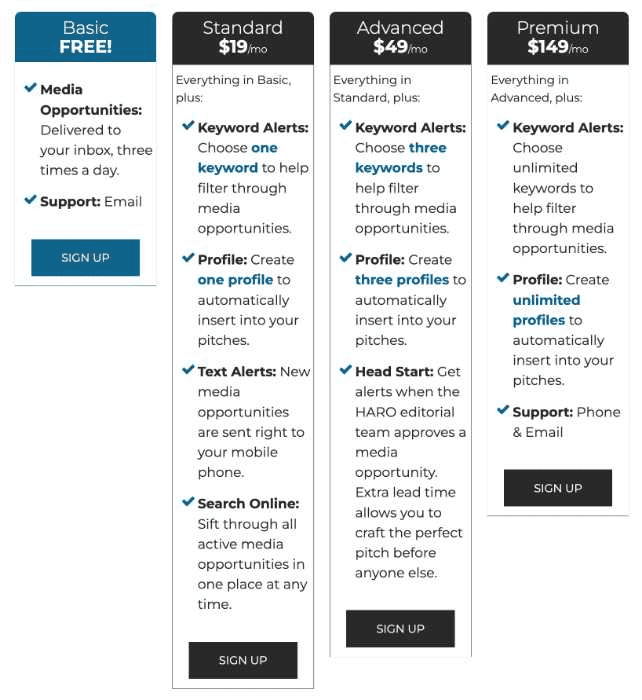The biggest mistake I see in small businesses that rely on their digital presence to grow revenue is to ignore building an SEO presence. Why do they do that?
Well, it takes time and consistency. And you won’t be sure of the results that you’ll get. Link building with HARO is no different. However, if you have the right expertise to offer, you have a great chance of earning media coverage.
Every day, journalists send out requests for sources on various topics. If you’re an expert on one of these topics, you can respond to the journalist’s request and provide them with the necessary information. In exchange for your help, the journalist will typically include a link to your website in their article.
So not only does this help you get high-quality links, but it also helps increase your visibility in search engines and grow your credibility as an expert in your field. Below, I’ll cover the ins and out of the service and how bloggers can use the tool to earn media and elevate the website’s link profile.
Table of Contents
ToggleWhat Is HARO?
HARO stands for Help A Reporter Out. It is a service owned by Cision that connects journalists with sources who can provide information or quotes for their stories. Businesses with blogs that rank lower than one million on SimilarWeb can also submit queries to get sources. For journalists and these online bloggers, it’s a great way to add expertise and authority to articles.
But for small businesses and SEOs, we have the opportunity to be the source for these high-quality websites. And in the trade-off, typically, a link to our website is provided. Instead of pitching journalists for stories they aren’t looking for, we have an opportunity to slot right in and earn some press coverage.
What are the benefits of using HARO?
The benefits of using HARO only are immense for a small business. You can earn backlinks from the established press and build your public relations presence. When customers search for you especially, they might just see your quotes in Forbes or the Washington Post. I sure wouldn’t mind that.

But more specifically, there are benefits that anyone in digital marketing will understand. More backlinks, especially from reputable sources, can increase website traffic by increasing your website’s domain reputation.
Read: The Remarkably Sizable Power of a Backlink Exchange Engine
Does HARO cost money? How much does HARO cost?
HARO offers a free service. However, they do have paid plans to get access to more features. These include text alerts, a prepared profile to include in your pitches to media outlets, and the ability to search online through opportunities. Other link-building tools like Respona track queries and allow you to search them, so it’s up to you to decide where a paid account is needed.

How Does HARO Work?
HARO works by sending out daily emails to its subscribers with a list of story ideas that journalists are working on. If you see a story you feel you could contribute, you simply reply to the email with your information or quote.
If the journalist decides to use your information or quote in their story, they will include attribution back to your website. This is where the link building comes in. By including a link to your website, you can increase your website’s domain authority and its ranking in the SERP.
Also Read: What is White Hat Link Building?
Is earning links with HARO realistic?
Help A Reporter Out may not be the best option if you’re looking for an easy way to earn links. While HARO can be a great source of link opportunities, it’s important to remember that each opportunity takes time to write and a bit of luck to secure.
To succeed with HARO, you need to be a good writer and produce high-quality content quickly. In addition, you’ll need to be quick on your feet and able to respond to opportunities as they come in.
While earning links with HARO is possible, it’s important to set realistic expectations and be prepared to put in the work. It can take months to see results. But given the quality of links you can earn, it could be worth it.
How To Use HARO For Link Building
Here’s how you can use HARO for link building:
-
Sign up for a free account
-
Once signed up, you’ll receive daily email digests with journalists’ requests on various topics.
-
Browse through the requests and see if there’s anything you can help with. If there is, simply click “pitch now” and submit your response directly to the journalist.
-
If the journalist uses your information in their article, they’ll follow up. And typically include a link to your website.
-
Repeat this process daily and watch your domain authority (and traffic) grow over time!
Sign up for a “basic” HARO account
The first step is to create a basic account on the HARO website. It isn’t necessary to get a paid plan unless you’re keen to build a link-building agency. Sign up on the HARO website, confirm your account, and then choose which categories you’d like to get queries you’d like to receive in your inbox. Be warned, the HARO site is a little clunky. Luckily, once you’re signed up you’ll rarely interact with it.
By default, you’ll be signed up for all categories. You can stick with that or opt in to any of the following:
-
High Tech Biotech and Healthcare
-
Business and Finance
-
Energy and Green Tech
-
Lifestyle and Fitness Sports
-
Entertainment and Media
-
Public Policy and Government
-
Education
-
General
-
Giftbag
-
Travel
-
UK
Browse daily email digests with journalists’ requests on various topics.
Three times per day, HARO sends an email with a digest of opportunities and queries that are your opportunity for media coverage. Here’s when they go out:
-
Morning Edition: 5:40 am ET
-
Afternoon Edition: 12:40 pm ET
-
Evening Edition: 5:40 pm ET.
These alerts will contain a list of opportunities that you can apply for. Read through each opportunity carefully before applying, as some may require additional steps (like filling out a form or completing a survey).
Pitch on queries where you have expertise
Browse through the requests and see if there’s anything you can help with. If there is, simply click on the query to be magically scrolled to the right query in the email.

Once you’ve found a HARO query you’re qualified for and interested in, it’s worth checking their site credibility. It might not be worth your time writing in if the query comes from a blog with a lower domain authority than yours.
Typically, you’ll be able to see which media outlet is looking to get your feedback. Often, you can tell immediately if it’s a reputable site just by recognizing the brands.
In the screenshot below, I would quickly open their website. With this public relations site, I can see with the Ahrefs toolbar that they have a domain reputation of 67, so we’re good to go. In the case of an anonymous submission, the HARO website suggests it’s likely to come from a larger media publication.

If you believe it’s a fit and are still before the deadline, it’s time to write your response! You’ll typically need to write a brief pitch explaining why you’re the best person for the job. Be sure to showcase your expertise, provide in depth insights, and highlight any relevant experience or qualifications.
If the journalist uses your information in their article, they’ll follow up. And typically include a link to your blog.
The reporter will contact you if your pitch is successful to set up an interview or request additional information. This is a great opportunity to build a relationship. Do it successfully, and you’ll have a great chance to build more links in the future.
Repeat this process daily and watch your domain authority (and traffic) grow over time!
Let’s be blunt, HARO link building takes time. Journalists will get 50-100 great pitches for each query they put out with HARO. But consistency is the key to earning these links. Schedule a 20-minute slot in your calendar when any of the three emails go out. Use this time to find a query that you can speak to best and write a good pitch.
How to Write a Good Pitch for a HARO Query
First, read the HARO query carefully and understand what the journalist is looking for. If you can provide what they need, great; if not, there’s no point in responding.
If you’re ready to respond, use the same email address as your HARO account, or your response won’t reach the journalist.
Write a descriptive subject line
Second, write a subject line that accurately reflects the content of your email. Typically the queries in HARO already have a title, so you can just reference this.
Don’t make it complicated. This will help the journalist sort through the responses and quickly identify the ones that are relevant to their needs.
Keep your email short and skimmable
Third, keep your email brief and to the point. Journalists are busy and don’t have time to read long, rambling emails. Get straight to the point and provide the knowledge they need. Proofread your response before hitting send – mistakes can reflect poorly on you and your company
Add a link to your site’s relevant content
If you’ve already written a post on your site about their query, you can also link it there. This is a great way to show expertise and authority.
Prepare a re-usable email template
Fourth, I suggest having a prepared email template or signature with relevant information, such as:
- Your name
- Your job title (ex.: Head Honcho of YourWebsite.com),
- Company Name
- Website (after all, we want that link)

FAQs about Help a Reporter Out
Is HARO good for backlinks?
It’s a great way to get your name out there and to build relationships with reporters. However, I wouldn’t recommend using it as a primary source of backlinks. Add variety to your backlink-building strategy through guest posting and publishing quality content that people want to share.
Does HARO help SEO?
A well-written HARO response can help with SEO if the journalist includes a link to your blog. That’s because a backlink from a high-quality site such as a media outlet is always beneficial for SEO.
Is HARO free for journalists?
Yes, Help-a-Reporter-Out is free for journalists. However, a SimilarWeb ranking lower than one million for online publications is required.
When do HARO emails go out?
HARO emails go out thrice on weekdays like clockwork at 5:40 am ET, 12:40 pm ET, and 5:40 pm ET. Be ready at those times to quickly answer and be more like to have your responses featured.
How many people use HARO?
According to their website, there are more than a million sources ready to respond.
Wrapping up HARO Link Building
HARO is a great way to get high-quality links and grow your reputation as an expert in your field. By responding to journalists’ requests daily, you can provide them with the information they need for their stories. The journalist will typically include a link to your website in their article. This process can help improve your blog’s search engine ranking and traffic over time!



